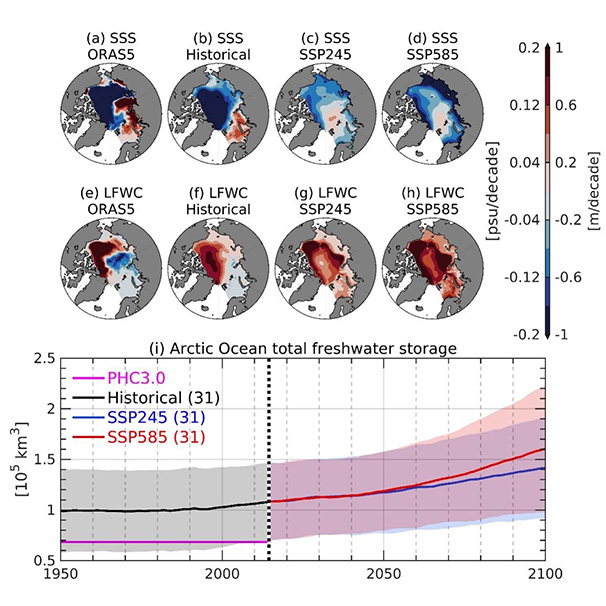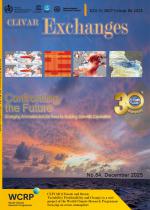The Barents Sea Opening: shifting from a freshwater sink to source for the Arctic Ocean

Linear trends of CMIP6 MMM (a-d) sea surface salinity (SSS) and (e-h) liquid freshwater content (LFWC) and (i) the total liquid freshwater storage in the Arctic Ocean. (a, e) ORAS5 trends over 1979-2014,; (b, f) CMIP6 historical trends over 1979-2014; (c, g) CMIP6 projected trends over 2015-2100 in the SSP2-4.5 scenario; (d, h) CMIP6 projected trends over 2015-2100 in the SSP5-8.5 scenario. The label on the left side of the color bar corresponds to SSS trend and the right label corresponds to LFWC trend. The number in parenthesis in the legend of (i) means the number of models used in the ensemble analysis. Shading depicts the range of one standard deviation.
The Arctic Ocean is freshening, rendering strong implications on changes in the Arctic physical and biogeochemical environment. Our knowledge about possible future Arctic changes relies on results from Coupled Model Intercomparison Project (CMIP) models. Recently, together with colleagues, two members from CLIVAR Ocean Model Development Panel (OMDP) conducted a comprehensive analysis on the Arctic sea surface salinity (SSS), liquid freshwater content (LFWC) and freshwater budget by comparing the CMIP6 to the CMIP5 results, showing that the salinity of the Barents Sea Opening is projected to keep declining in the future. The result is recently published on Earth’s Future (http://dx.doi.org/10.1029/2022EF002878).
An improvement can be found in the SSS simulation in CMIP6, but the large inter-model spread in both CMIP phases makes the improvement insignificant. In CMIP6, the Arctic LFWC remains to be overestimated in the historical simulation. A strong freshening trend is projected in the Arctic Ocean, with the freshwater sources from river runoff and net precipitation persistently increasing in a warming climate. The inflow through the Barents Sea Opening is likely to change from an Arctic freshwater sink to a source around 2050. At the end of this century, the total liquid freshwater storage is expected to rise by 60% under the SSP5-8.5 scenario. In contrast to the increasing LFWC, the solid freshwater content in the form of sea ice is projected to continue declining, with projected summer sea ice vanishing around 2050.

(a) Annual mean freshwater sources and sinks for the Arctic Ocean in 1950-2100 (historical and under scenario SSP5-8.5) from CMIP6 multi-model mean (MMM) results. (b) the same with (a) but for historical and SSP2-4.5. The thickness of each color stripe represents the quantity of that source or sink while the black lines are the sum of all sources and sinks. Solid freshwater transport through the four gateways is shown as a whole. The dashed lines denote the demarcation between the historical simulation and future projection. Positive indicates freshwater flux into the Arctic Ocean while negative stands for outflow.
*************************************************************************
(Summary written by Dr. Shizhu Wang)
Wang S, Wang Q, Wang M, et al. Arctic Ocean freshwater in CMIP6 coupled models[J]. Earth's Future, e2022EF002878. http://dx.doi.org/10.1029/2022EF002878











Add new comment